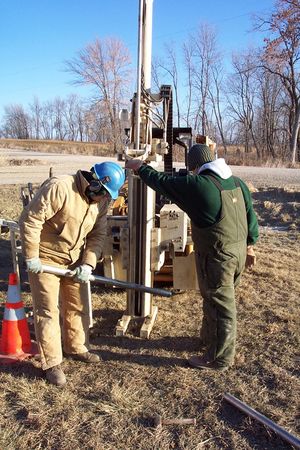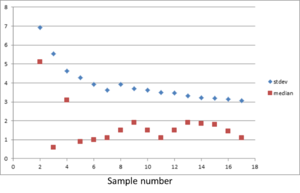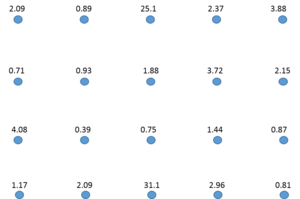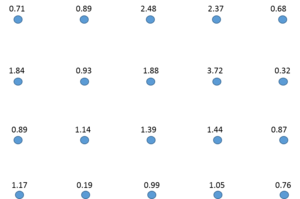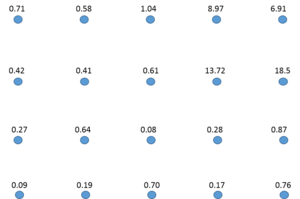
Determining soil infiltration rates
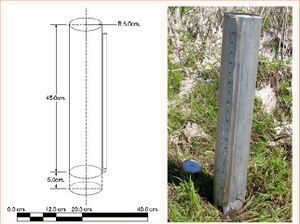
This page provides a literature review, case studies, and recommendations for field measurement of soil infiltration. Properly conducted infiltration tests are preferred to estimates of soil infiltration based on borings. This page includes example calculations and links to related pages in this manual.
Contents
- 1 Overview of soil infiltration
- 2 Soil infiltration rate measurement techniques
- 3 Infiltration rate measurement case studies
- 4 Types of infiltration measurement devices
- 5 Soil property determination for infiltration SCM design
- 6 Test for bioretention cell acceptance
- 7 Calculating soil infiltration rate and example calculations
- 8 Related pages
- 9 References
Overview of soil infiltration
During rainfall, a saturated zone forms quickly at the soil surface as rainfall causes surface ponding. The wetting front advances downward into the soil as infiltration continues, causing an increase in the moisture content as a function of depth (Hillel, 1982). A transmission zone between the saturated zone and the wetting front conveys water deeper into the soil profile. Infiltration testing is meant to mimic these natural processes and informs the design of stormwater infiltration practices. During an infiltration test, infiltration rate decreases over time as the soil becomes saturated. Infiltration rate tends to asymptotically approach the saturated hydraulic conductivity (the maximum water transmission rate of the soil) after long periods of infiltration, though entrapped air in the soil never results in perfectly saturated flow in the vadose zone. Since infiltration rate varies both spatially and temporally as a result of being dependent on multiple soil properties, such as texture, compaction, and presence of vegetation, it is useful to have a large number of samples to estimate the median value for design of an infiltration practice (Warrick and Nielson, 1980; Chowdary et al., 2006).
There are consequences for both overestimation and underestimation of infiltration rate beneath a stormwater control measure (SCM). If infiltration rate is overestimated during the infiltration test, system performance suffers once the SCM is constructed. Volume reduction, mitigation of peak flow rate, and groundwater recharge will all be overestimated during the design phase, resulting in a lack of hydrologic function and pollutant mitigation. Consequences of underestimation of infiltration rate are typically observed in increased construction costs due to the addition of underdrains, deeper bioretention media depths, and reduced ability to utilize internal water storage (submerged) zones as part of the design (Brown et al., 2011). Internal water storage is typically not recommended in HSG D soils or soils with infiltration rates less than 0.05 inches per hour.
Soil infiltration rate measurement techniques
Because of the potential for 3-dimensional flow in a bore hole percolation test (wherein water is flooded into a bore hole and flow rate measured), this method should not be used when designing a stormwater infiltration device. A method which mirrors the one-dimensional exfiltration from a bioretention cell or infiltration device is desired.
Typically, these measurements are made with an infiltrometer – a circular device which allows water to be ponded on the soil surface. Measurements may be taken as a function of time to determine the design infiltration rate of the soil. For instance, ASTM D3385 (2003) describes field measurement of infiltration rate using the double ring infiltrometer method. The primary reason for the secondary, outer ring is to reduce edge effects and produce one-dimensional, vertical flow in the inner ring, where measurements of depth as a function of time are made. Some researchers have observed that field, laboratory, and numerical modeling tests have shown a large diameter, single ring infiltrometer provides measurements that are of similar accuracy to the double ring test (Bouwer, 1986; Reynolds et al., 2002). Another study showed that measurements of infiltration rate with single ring infiltrometers were slightly higher than those of a double ring infiltrometer, but the measurements were not significantly different (Walsh and McDonnell, 2012). Single ring cylinders should be as large in diameter as possible to obtain accurate results, with diameter of 3 feet or more preferable (Bouwer, 1986). Tests should be run until a constant intake rate (inches per hour) into the soil is achieved. However, no ASTM standard is available for single ring infiltrometer measurements.
Another method for estimating the soil infiltration rate is the Modified Phillip-Dunne Permeameter, which was developed by the University of Minnesota. It makes use of a falling head test within a single metal cylinder pounded 2 inches into the soil to determine infiltration rate. An initial soil moisture content measurement must be made, and then the cylinder is filled with water. As the permeameter drains, measurements of stage and time are taken. Then, a final measurement of soil moisture content is aggregated into a post-processing spreadsheet, where saturated hydraulic conductivity is calculated.
Infiltration rate measurement case studies
Asleson, (2007) summarizes pros and cons of five types of infiltration measurement devices (mini-disk infiltrometer, tension infiltrometer, Guelph permeameter, modified Phillip-Dunne permeameter, and double-ring infiltrometer). In one rain garden, Asleson (2007) estimated an infiltration rate of 0.72 in/hr from 40 mini-disk measurements. Flood test had an average Ksat nearly four times higher, at 2.71 in/hr. Phillip-Dunne and double-ring infiltrometer measurements were near 1 in/hr, suggesting that flood tests of completed bioretention/infiltration devices may be the best method for determining functionality. It appears that current methods of soil infiltration measurements under-predict true media infiltration rate.
Ahmed et al. (2012) attempted to determine a relatively rapid, low cost, low effort approach for determining soil infiltration rate. They performed infiltration measurements on six rain gardens, three turf areas, three swales, an infiltration basin, and proposed rain garden/infiltration areas. They used the Modified Phillip-Dunne infiltrometer to make these measurements. Measurements had large variability (coefficients of variance greater than unity) for all SCM types. Turf had much lower Ksat values than all other SCMs due to soil compaction. The authors contend that due to the high coefficient of variation, 10 to 20 infiltration measurements are needed within a proposed SCM’s footprint to capture the high spatial variability and obtain a median value that will represent the performance of the SCM once it is constructed.
Gulliver and Anderson (2008) provided very detailed descriptions of infiltration measurement device, including: single and double-ring infiltrometers, Guelph permeameters, tension infiltrometers, and Phillip-Dunne Permeameters. In-depth details for how to measure infiltration rates with each device are given, as well as the theory behind the measurements. Equations for calculating infiltration rates based on field measurements with each device are also provided. The authors contest that the most accurate measurement of infiltration rate is post-installation flood testing. Wenck Associates (2008) completed infiltration rate measurements at five infiltration basins with the Coon Creek Watershed District (Minnesota). The authors used both flood tests of the basins and modified Phillip-Dunne permeameter tests to determine infiltration rates for each basin. At two of three sites with data reported, the modified Phillip-Dunne test under-predicted the infiltration rate of the flood test by as much as a factor of sixteen. At the other site, the modified Phillip-Dunne test resulted in an infiltration rate 1.6 inches per hour higher than that from the flood test. This suggests that methodologies for soil infiltration rate measurement need to be refined, and we recommend that this be an area that is focused on for future research.
Philips and Kitch (2011) compare in-situ methods of infiltration rate measurement at three sites in southern California. Their data set includes those from the pilot infiltration test (common test in Washington state, PIT), double-ring infiltrometer, borehole tests, and hydraulic conductivity estimates (from grain size distributions and cone penetrometer field measurements). The PIT test involved digging a large hole (10 ft by 15 ft bottom dimensions) to the proposed infiltrative surface (bottom of infiltration basin or top of in-situ soil for bioretention cell). Water is then ponded to 2-4 feet rapidly, and maintained at a constant head for a minimum of 24 hours. The water flow rate necessary to maintain this constant water level is recorded as the infiltration rate of the soil. The authors contend that the PIT test is the most rigorous known method of infiltration measurement, and that it provides the most accurate pre-construction estimation of infiltration rate. However, measurements made using the PIT test are laborious, costly, and time-consuming. NOTE: this technique utilizes soil pits for a specific method developed in Washington State. It is included as a case study here but is not specifically recommended and conflicts with guidance provided below. The methodology, however, appears to be an acceptable approach for field testing.
Types of infiltration measurement devices
Various devices are available for measurement of infiltration within a proposed SCM, including the single ring infiltrometer, double ring infiltrometer, Philip-Dunne permeameter, Guelph permeameter, and tension infiltrometer. Some infiltration measurement devices also require soil moisture to be measured, which may be measured using methods in Klute (1986). A detailed description of each technique for infiltration rate measurement, including methods and required post-processing, may be found in Gulliver et al. (2010). Methods typically use either a constant or falling head of water above the infiltrative surface. Measurements of infiltrated volume as a function of time are made, with design infiltration rate or intake rate taken as the infiltration rate once the measurement has approached a horizontal asymptote.
Soil property determination for infiltration SCM design
Designers should evaluate soil properties during preliminary site layout with the intent of installing bioretention or bioinfiltration practices on soils with the highest infiltration rates (HSG A and B). Preliminary planning for the location of an infiltration device may be completed using a county soil survey or the NRCS Web Soil Survey (http://websoilsurvey.nrcs.usda.gov/app/HomePage.htm). These publications provide HSG information for soils across Minnesota. To ensure long-term performance, however, field soil measurements are desired to provide site-specific data.
All soil analysis and infiltration testing must be completed within the proposed boundary of the SCM. Soil borings for building structural analysis will not be acceptable.
In all design scenarios, a minimum of one soil boring (two are recommended) shall be completed to a depth 5 feet below the bottom of the proposed bioretention SCM (Dakota County Soil and Water Conservation District, 2012) per ASTM D1586 (ASTM, 2011). For bioretention SCMs with surface area between 1000 and 5000 square feet, two borings shall be made. Between 5000 and 10000 square feet, three borings are needed, and for systems with greater than 10000 square feet in surface area, 4 or more borings are needed. For each additional 2500 square feet beyond 12,500 square feet, an additional soil boring should be made. Soil borings must be undertaken during the design phase (i.e. prior to the commencement of construction) to determine how extensive the soil testing will be during construction. Borings should be completed using continuous split spoon sampling, with blow counts being recorded to determine the level of compaction of the soil. Soil borings are needed to understand soil types, seasonally high groundwater table elevation, depth to karst, and bedrock elevations. Soil profiles should be recorded for each layer encountered in the boring, including information on soil texture, Munsell soil color,redoximorphic features, soil structure, occurrence and abundance of roots, and occurrence of saturated soils or lenses.
Design infiltration rate
For design purposes, there are two ways of determining the soil infiltration rate. The first, and preferred method, is to field-test the soil infiltration rate using appropriate methods described below. The other method uses the typical infiltration rate of the most restrictive underlying soil (determined during soil borings).
If infiltration rate measurements are made, a minimum of one infiltration test in a soil pit must be completed at the elevation from which exfiltration would occur (i.e. interface of gravel drainage layer and in situ soil). When the SCM surface area is between 1000 and 5000 square feet, two soil pit measurements are needed. Between 5000 and 10000 square feet of surface area, a total of three soil pit infiltration measurements should be made. Each additional 5000 square feet of surface area triggers an additional soil pit. The median measured infiltration rate should be utilized for design. Soil pits should be dug during the design phase and should be a minimum of two feet in diameter for measurement of infiltration rate. Infiltration testing in the soil pit can be completed with a double-ring infiltrometer or by filling the pit with water and measuring stage vs. time. If the infiltration rate in the first pit is greater than 2 inches per hour, no additional pits shall be needed. Note that filling a pit with water is potentially subject to errors resulting from three-dimensional flow from the pit into the underlying soil. This issue can be addressed by utilizing larger pits and ensuring a steady state infiltration rate is established. For an example, see the Washington State pilot infiltration test.
Alternatively, a permeameter can be used to field test infiltration rate. Guidance for the number of permeameter tests required based on bioretention surface area is given in the table below. The Modified Philip-Dunne permeameter is a widely used and recommended permeameter because of its ease of use. Modified Philip-Dunne permeameter tests may be made in conjunction with soil borings or may be completed using a handheld soil auger. Borings should be lined with a plastic sleeve to prevent infiltration from the sides of the borehole (i.e. restrict flow to vertical infiltration). Soil borings should be filled with water. The time for the borehole to drain should be recorded and divided by the initial ponding depth in the borehole to provide an infiltration rate measurement. The design infiltration rate should be the lower of the median soil pit infiltration rate or the median borehole method infiltration rate.
Design infiltration rates, in inches per hour, for A, B, C, and D soil groups. Corresponding USDA soil classification and Unified soil Classifications are included. Note that A and B soils have two infiltration rates that are a function of soil texture.*
The values shown in this table are for uncompacted soils. This table can be used as a guide to determine if a soil is compacted. For information on alleviating compacted soils, link here. If a soil is compacted, reduce the soil infiltration rate by one level (e.g. for a compacted B(SM) use the infiltration rate for a B(MH) soil).
Link to this table
| Hydrologic soil group | Infiltration rate (inches/hour) | Infiltration rate (centimeters/hour) | Soil textures | Corresponding Unified Soil ClassificationSuperscript text |
|---|---|---|---|---|
| Although a value of 1.63 inches per hour (4.14 centimeters per hour) may be used, it is Highly recommended that you conduct field infiltration tests or amend soils.b See Guidance for amending soils with rapid or high infiltration rates and Determining soil infiltration rates. |
gravel |
GW - Well-graded gravels, fine to coarse gravel GP - Poorly graded gravel |
||
| 1.63a | 4.14 |
silty gravels |
GM - Silty gravel |
|
| 0.8 | 2.03 |
sand |
SP - Poorly graded sand |
|
| 0.45 | 1.14 | silty sands | SM - Silty sand | |
| 0.3 | 0.76 | loam, silt loam | MH - Elastic silt | |
| 0.2 | 0.51 | Sandy clay loam, silts | ML - Silt | |
| 0.06 | 0.15 |
clay loam |
GC - Clayey gravel |
|
1For Unified Soil Classification, we show the basic text for each soil type. For more detailed descriptions, see the following links: The Unified Soil Classification System, CALIFORNIA DEPARTMENT OF TRANSPORTATION (CALTRANS) UNIFIED SOIL CLASSIFICATION SYSTEM
- NOTE that this table has been updated from Version 2.X of the Minnesota Stormwater Manual. The higher infiltration rate for B soils was decreased from 0.6 inches per hour to 0.45 inches per hour and a value of 0.06 is used for D soils (instead of < 0.2 in/hr).
Source: Thirty guidance manuals and many other stormwater references were reviewed to compile recommended infiltration rates. All of these sources use the following studies as the basis for their recommended infiltration rates: (1) Rawls, Brakensiek and Saxton (1982); (2) Rawls, Gimenez and Grossman (1998); (3) Bouwer and Rice (1984); and (4) Urban Hydrology for Small Watersheds (NRCS). SWWD, 2005, provides field documented data that supports the proposed infiltration rates. (view reference list)
aThis rate is consistent with the infiltration rate provided for the lower end of the Hydrologic Soil Group A soils in the Stormwater post-construction technical standards, Wisconsin Department of Natural Resources Conservation Practice Standards.
bThe infiltration rates in this table are recommended values for sizing stormwater practices based on information collected from soil borings or pits. A group of technical experts developed the table for the original Minnesota Stormwater Manual in 2005. Additional technical review resulted in an update to the table in 2011. Over the past 5 to 7 years, several government agencies revised or developed guidance for designing infiltration practices. Several states now require or strongly recommend field infiltration tests. Examples include North Carolina, New York, Georgia, and the City of Philadelphia. The states of Washington and Maine strongly recommend field testing for infiltration rates, but both states allow grain size analyses in the determination of infiltration rates. The Minnesota Stormwater Manual strongly recommends field testing for infiltration rate, but allows information from soil borings or pits to be used in determining infiltration rate. A literature review suggests the values in the design infiltration rate table are not appropriate for soils with very high infiltration rates. This includes gravels, sandy gravels, and uniformly graded sands. Infiltration rates for these geologic materials are higher than indicated in the table.
References: Clapp, R. B., and George M. Hornberger. 1978. Empirical equations for some soil hydraulic properties. Water Resources Research. 14:4:601–604; Moynihan, K., and Vasconcelos, J. 2014. SWMM Modeling of a Rural Watershed in the Lower Coastal Plains of the United States. Journal of Water Management Modeling. C372; Rawls, W.J., D. Gimenez, and R. Grossman. 1998. Use of soil texture, bulk density and slope of the water retention curve to predict saturated hydraulic conductivity Transactions of the ASAE. VOL. 41(4): 983-988; Saxton, K.E., and W. J. Rawls. 2005. Soil Water Characteristic Estimates by Texture and Organic Matter for Hydrologic Solutions. Soil Science Society of America Journal. 70:5:1569-1578.
Recommended number of soil borings, pits or permeameter tests for bioretention design. Designers select one of these methods.
Link to this table
| Surface area of stormwater control measure (BMP)(ft2) | Borings | Pits | Permeameter tests |
|---|---|---|---|
| < 1000 | 1 | 1 | 5 |
| 1000 to 5000 | 2 | 2 | 10 |
| 5000 to 10000 | 3 | 3 | 15 |
| >10000 | 41 | 41 | 202 |
1an additional soil boring or pit should be completed for each additional 2,500 ft2 above 12,500 ft2
2an additional five permeameter tests should be completed for each additional 5,000 ft2 above 15,000 ft2
NOTE: In the table above, the recommended number of permeameter tests increases by 5 tests per each additional 5000 square feet of surface area. For larger sites, this can result in a very large number of samples. There may be situations where fewer permeameter tests may be used (5 is the minimum) . For example, in situations where the variability in saturated hydraulic conductivity between measurements is not great, fewer samples may be taken. One method for determining the number of samples is to plot standard deviation versus number of samples. Measurements may be halted when the standard deviation becomes relatively constant from one sample to the next. In the example to the right the standard deviation flattens at about 7 to 10 samples. Therefore, 7 to 10 samples would be an appropriate number of samples for this situation.
Test for bioretention cell acceptance
Post-construction, it is important to field-test the drawdown rate of the bioretention cell to determine whether it is functioning as intended (Wenck Associates, 2008). This is the most accurate method to determine if a bioretention cell is correctly functioning, since it accounts for spatial variability in infiltration rates. Post-construction, bioretention cells and infiltration devices should be flooded with water and the time for complete drawdown to occur (i.e. no standing water in the bowl) should be recorded. An electronic stage recorder, a staff gage and wildlife camera, or a pulley float stage recorder may be used to measure drawdown. By taking the quotient of initial water depth to drawdown time, an estimation of drawdown rate can be obtained. The device may be either flooded with water from a fire hydrant or other source, or a natural rainfall event which fills the bowl entirely may also be utilized for this purpose. Media drawdown rates should fall between 1 inch per hour and 8 inches per hour immediately after construction to meet acceptance criteria.
Calculating soil infiltration rate and example calculations
Soil infiltration rates can vary widely over short distances, even in soils that appear to be homogeneous. Ahmed (2011) conducted infiltration tests for several stormwater infiltration practices using a Modified Philip Dunne (MPD) Infiltrometer. Coefficients of variation were typically greater than 1 and arithmetic means were consistently greater than geometric means, often by a factor of 2 or more. If the data are represented by a log-normal distribution, it is preferred to use the geometric mean to estimate the infiltration rate. If there are a few extreme values in the data (i.e. very high or very low compared to the rest of the data), the median is preferred. The arithmetic mean should not be used to estimate the infiltration rate.
Example calculations
In the first example, shown on the left, the arithmetic mean is 4.47 inches per hour, the geomean is 2.01, and the median is 1.99. There are two very large values (25.1 and 31.1 inches per hour) so the median is recommended, although the geomean and median are close. In example 2, shown in the upper right, the arithmetic mean is 1.29 inches per hour, the geomean is 1.06, and the median is 1.02. There do not appear to be any very large or small values and the geomean is recommended. In example 3, shown on the lower right, the arithmetic mean is 2.80 inches per hour, the geomean is 0.76, and the median is 0.63. However, note that there are four very high infiltration rates in the upper right portion of the schematic, compared to much lower rates in the remainder of the schematic. The results suggest there may be two distinct infiltration regimes and borings should be conducted to confirm this. If borings confirm this, then determine the infiltration rates for each area. In this case, the geomean for the area with the lower infiltration rates is 0.39 and for the higher infiltration rate area the geomean is 11.2 inches per hour.
In all cases, the resulting values determined above should be reduced by a factor of 2 to account for reduced infiltration over time. Therefore, the resulting infiltration rates are 1.0 inches per hour for example 1, 0.38 inches per hour for example 2, and for the high infiltration area in example 3 the calculated rate is 5.6 inches per hour.
Related pages
- Stormwater infiltration Best Management Practices
- Stormwater infiltration
- BMPs for stormwater infiltration
- Overview of stormwater infiltration
- Understanding and interpreting soils and soil boring reports for infiltration BMPs
- Determining soil infiltration rates
- Cold climate considerations for infiltration practices - See [1], [2]
- December 15 webinar (powerpoint and link to presentation)
References
- Ahmed, F., Gulliver, J.S. and J.L. Nieber. 2011. A New Technique to Measure Infiltration Rate for Assessing Infiltration of BMPs. Presented at 12th International Conference on Urban Drainage, Porto Alegre/Brazil, 11-16 September 2011.
- American Society for Testing and Materials (ASTM) D1586. (2011). Standard test method for standard penetration test (SPT) and split-barrel sampling of soils. Annual book of ASTM standards, vol. 4.02. ASTM International.
- ASTM D3385. (2003). Standard test method for infiltration rate of soils in field using double-ring infiltrometer. Annual book of ASTM standards, vol. 4.02. ASTM International.
- Asleson, B. (2007). Assessment of the Performance of Stormwater Best Management Practices (BMPs). Powerpoint presentation.
- Bouwer, H. (1986). Intake Rate: Cylinder Infiltrometer. In: Methods of Soil Analysis, Part 1: Physical and Mineralogical Methods, Klute, A. (Ed.). SSSA, Wisconsin, ISBN-10: 0891188118, pp: 825-844.
- Brown, R.A., Hunt, W.F., and Skaggs, R.W. (2011). Long-term modeling of bioretention hydrology with DRAINMOD. Final Report for Water Resources Research Institute of the University of North Carolina. Project #70255.
- Chowdary, V.M., Rao, M.D., and Jaiswal, C.S. (2006). Study of infiltration process under different experimental conditions. Agricultural Water Management. 83, 69-78.
- Dakota County Soil and Water Conservation District. (2012). Low Impact Development Standards for Dakota County, Minnesota.
- Gulliver, J.S., J.L. Anderson (eds). 2008. Assessment of Stormwater Best Management Practices. University of Minnesota.
- Gulliver, J.S., A.J. Erickson, and P.T. Weiss (editors). (2010). Stormwater Treatment: Assessment and Maintenance. University of Minnesota, St. Anthony Falls Laboratory. Minneapolis, MN.
- Hillel, D. (1982). Introduction to soil physics. Academic Press, San Diego, CA.
- Klute, A. (1986). Methods of Soil Analysis: Part 1, Physical and Mineralogical Methods. Soil Science Society of America and American Society of Agronomy. Madison, WI.
- Philips, C. E., and W. A. Kitch. 2011. A review of methods for characterization of site infiltration with design recommendations. Paper presented at 43rd Symposium on Engineering Geology and Geotechnical Engineering, University of Las Vegas, Las Vegas, NV, March 23-25, 2011.
- Reynolds, W.D., D.E. Elrick, E.G. Youngs, A. Amoozegar, H.W.G. Booltink, and J. Bouma. (2002). Saturated and fi eld-saturated water flow parameters. In J.H. Dane and G.C. Topp (ed.) Methodsof soil analysis. Part 4. Physical methods. SSSA Book Ser. 5. SSSA, Madison, WI. . p. 797–878.
- Walsh, E., and McDonnell, K.P. (2012). “The influence of measurement methodology on soil infiltrationrate.” International Journal of Soil Science. 7(4), 168-176.
- Warrick, A.W., and D. R. Nielsen. (1980). Spatial variability of soil physical properties in the field. In: Applications of Soil Physics. D. Hillel (ed.). Academic Press, New York, pp. 319-344.
- Wenck Associates, Inc. (2008). “Infiltration basin test results.” Prepared for: Coon Creek WatershedDistrict.
This page was last edited on 25 January 2023, at 23:33.

